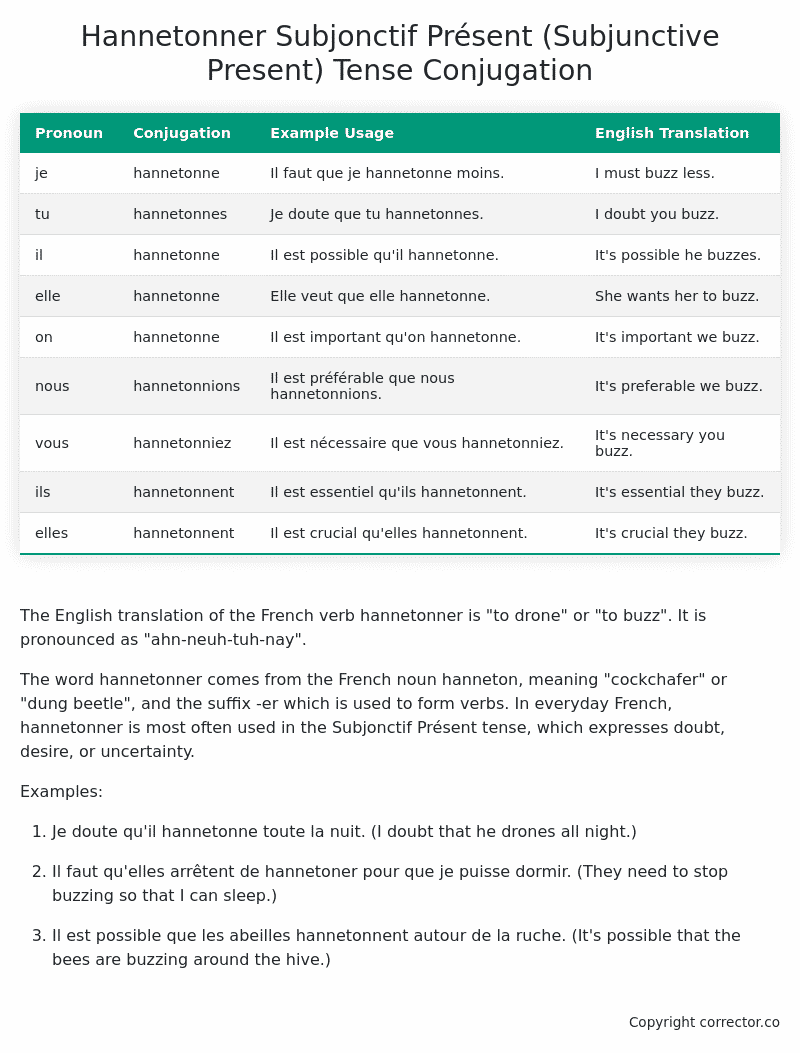Subjonctif Présent (Subjunctive Present) Tense Conjugation of the French Verb hannetonner
Introduction to the verb hannetonner
The English translation of the French verb hannetonner is “to drone” or “to buzz”. It is pronounced as “ahn-neuh-tuh-nay”.
The word hannetonner comes from the French noun hanneton, meaning “cockchafer” or “dung beetle”, and the suffix -er which is used to form verbs. In everyday French, hannetonner is most often used in the Subjonctif Présent tense, which expresses doubt, desire, or uncertainty.
Examples:
-
Je doute qu’il hannetonne toute la nuit. (I doubt that he drones all night.)
-
Il faut qu’elles arrêtent de hannetoner pour que je puisse dormir. (They need to stop buzzing so that I can sleep.)
-
Il est possible que les abeilles hannetonnent autour de la ruche. (It’s possible that the bees are buzzing around the hive.)
Table of the Subjonctif Présent (Subjunctive Present) Tense Conjugation of hannetonner
| Pronoun | Conjugation | Example Usage | English Translation |
|---|---|---|---|
| je | hannetonne | Il faut que je hannetonne moins. | I must buzz less. |
| tu | hannetonnes | Je doute que tu hannetonnes. | I doubt you buzz. |
| il | hannetonne | Il est possible qu’il hannetonne. | It’s possible he buzzes. |
| elle | hannetonne | Elle veut que elle hannetonne. | She wants her to buzz. |
| on | hannetonne | Il est important qu’on hannetonne. | It’s important we buzz. |
| nous | hannetonnions | Il est préférable que nous hannetonnions. | It’s preferable we buzz. |
| vous | hannetonniez | Il est nécessaire que vous hannetonniez. | It’s necessary you buzz. |
| ils | hannetonnent | Il est essentiel qu’ils hannetonnent. | It’s essential they buzz. |
| elles | hannetonnent | Il est crucial qu’elles hannetonnent. | It’s crucial they buzz. |
Other Conjugations for Hannetonner.
Le Present (Present Tense) Conjugation of the French Verb hannetonner
Imparfait (Imperfect) Tense Conjugation of the French Verb hannetonner
Passé Simple (Simple Past) Tense Conjugation of the French Verb hannetonner
Passé Composé (Present Perfect) Tense Conjugation of the French Verb hannetonner
Futur Simple (Simple Future) Tense Conjugation of the French Verb hannetonner
Futur Proche (Near Future) Tense Conjugation of the French Verb hannetonner
Plus-que-parfait (Pluperfect) Tense Conjugation of the French Verb hannetonner
Passé Antérieur (Past Anterior) Tense Conjugation of the French Verb hannetonner
Futur Antérieur (Future Anterior) Tense Conjugation of the French Verb hannetonner
Subjonctif Présent (Subjunctive Present) Tense Conjugation of the French Verb hannetonner (this article)
Subjonctif Passé (Subjunctive Past) Tense Conjugation of the French Verb hannetonner
Subjonctif Imparfait (Subjunctive Imperfect) Tense Conjugation of the French Verb hannetonner
Conditionnel Présent (Conditional Present) Tense Conjugation of the French Verb hannetonner
Conditionnel Passé (Conditional Past) Tense Conjugation of the French Verb hannetonner
L’impératif Présent (Imperative Present) Tense Conjugation of the French Verb hannetonner
L’infinitif Présent (Infinitive Present) Tense Conjugation of the French Verb hannetonner
Struggling with French verbs or the language in general? Why not use our free French Grammar Checker – no registration required!
Get a FREE Download Study Sheet of this Conjugation 🔥
Simply right click the image below, click “save image” and get your free reference for the hannetonner Subjonctif Présent tense conjugation!

Hannetonner – About the French Subjonctif Présent (Subjunctive Present) Tense
Formation of the Subjonctif Présent
Common Everyday Usage Patterns
Interactions with Other Tenses
Summary
I hope you enjoyed this article on the verb hannetonner. Still in a learning mood? Check out another TOTALLY random French verb conjugation!


